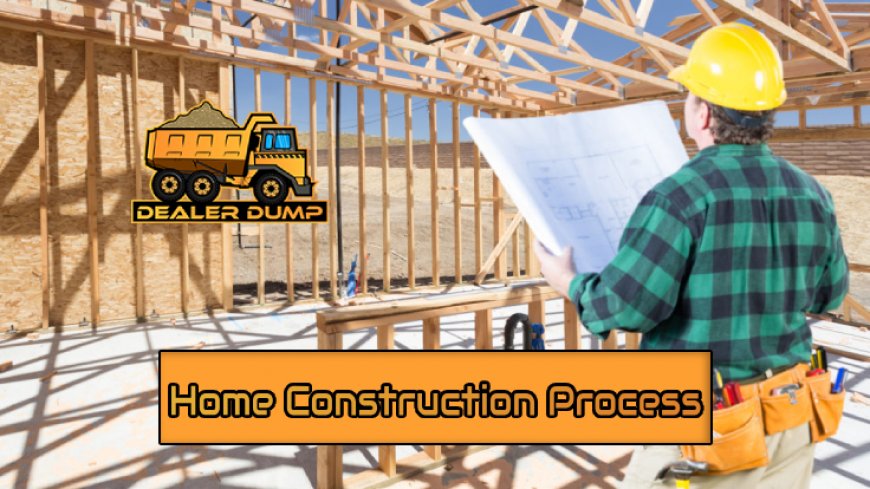Understanding The Process of Home Construction
Get to know the step-by-step process behind home construction to appreciate the craftsmanship behind your dream home.

Home construction process might be a mystery to many, but it's a fascinating journey that transforms a mere piece of land into a dwelling of dreams. Right from the initial preparations to the final touch-ups, every step of home construction demands meticulous planning and precise execution. This article aims to unravel the mystique behind the home construction process, leading you through each stage with detailed insights.
Demystifying the Home Construction Process
Let's embark on a journey of understanding what goes behind the making of a home. We will navigate you through initial site preparations, construction of foundations, framing, installation of services, interior and exterior finishing, and the ultimate move into your dream home. You'll learn not only the sequence of events but also the reason behind each step.
Table of Contents
- Site Preparation and Ground Work
- Laying the Foundations
- Framing – The Structural Backbone
- Installation of Services – The Lifelines of a Home
- Exterior Finishing – First Impressions
- Interior Finishing – The Comfort Zone
- Final Touches and Move-in
- Understanding the Home Construction Process - A Wrap-up
Site Preparation and Ground Work

Before construction begins, the site must be prepared to ensure a smooth building process. Site preparation involves several critical steps including clearing the land, grading it for proper drainage, and setting out the house's footprint on the property.
Land clearing involves removing rocks, trees, shrubbery, or old structures that may obstruct the construction. This process ensures the safety and efficiency of workers and allows for accurate placement of the new structure.
Grading, the process of leveling the land, is crucial for drainage. A well-graded site prevents potential water damage to the property.
Lastly, the footprint of the house is clearly marked on the site. This acts as a guide for the foundation, outlining the home's future location.
Laying the Foundations
The foundation of a house is like its backbone. It's what keeps the home standing tall and strong, and it forms the base for building everything else. Depending on the type of land and region's climate, different types of foundations are laid —from a shallow slab-on-grade foundation to a deep piled foundation.
- Footings: These are broader bases that distribute the weight of the house evenly. They are dug below the frost line (the depth at which the soil can freeze), filled with concrete, and then allowed to cure or set.
- Walls: After footings are set, the foundation walls, often made of concrete blocks or poured concrete, are erected. These walls provide a sturdy base to which the house's wooden frame will eventually be attached.
- Waterproofing and Drainage: The foundation walls are then waterproofed to protect against water damage. Foundation drains are installed around the perimeter to divert water away from the house.
Framing – The Structural Backbone
Once the foundation sets, it's time for the framing stage. This phase brings the dream home's structure to life as contractors erect the home's skeleton, outlining the rooms, doors, and windows.
Types of Framing
There are two main methods of framing: platform framing and balloon framing. Platform framing, the most common type, involves building one floor at a time. In contrast, balloon framing extends long, continuous studs for the height of the building from the foundation to the roof.
Framing also involves installing the sheathing, which are large panels attached to the frame, and the roof truss, which supports the roof structure. After this stage, the house starts taking a physical form that's recognizable as a home.
Installation of Services – The Lifelines of a Home
Once the framing is completed, the next step in the home construction process is to install the home's services. These "lifelines" of your home include plumbing, electrical, and HVAC (Heating, Ventilation, and Air Conditioning) systems.
Plumbing includes laying the pipes for water and waste, while electrical work involves wiring for lighting, outlets, and appliances. Your home's comfort is significantly influenced by the HVAC system responsible for heating and cooling.
A Well-lit notion: The Electrical System
While plumbing and HVAC installations are important, one of the most crucial elements of any home is its electrical system. It begins with a temporary power pole bringing electricity to the job site. After that, electricians install electrical boxes, run wires to the boxes, and establish the home's main panel box.
Exterior Finishing – First Impressions

After the home's services are installed, it's time for the exterior finishing. This is a significant phase of the home construction process as it gives the home its first eye-catching impression.
Exterior finish includes the application of a weather-resistant barrier, siding, roofing, and finally, windows and exterior doors. The quality and style of these elements define the aesthetics of your home and also ensure protection from external elements like weather and insects.
- Weather-Resistant Barrier: This layering is applied over the sheathing to protect against water leakage.
- Siding: This is the outermost visible layer. It could be vinyl, wood, stucco, or a variety of other materials depending on the homeowner's preference.
- Roofing: The roofing materials are installed atop the home for adequate protection from weather. It could range from asphalt shingles to metal or tile roofing.
- Windows and Exterior Doors: Finally, windows and the exterior doors are installed
Interior Finishing – The Comfort Zone

With the exterior complete, the focus shifts to the interior of the home, a space where comfort and aesthetics need to blend seamlessly. From drywall installation to painting, flooring, and installation of interior doors, every step is handled with precision to ensure a cozy and comfortable living space.
Drywall is installed to create the walls and ceilings of the home. Once it's installed and given a smooth finish, painting begins. Choosing the right colors can breathe life into your rooms, making them feel calm, energetic, cozy, or spacious, depending on your preference.
Flooring installation is the next significant step. The type of floor—be it hardwood, laminate, tile, or carpet—can dramatically change the look and feel of your home. Finally, interior doors and trim are installed, adding another layer of aesthetic appeal.
Final Touches and Move-in
The penultimate stage of the home construction process is applying the final finishing touches. This stage includes installation of light fixtures, countertops, cabinets, and appliances. Landscaping such as lawn seeding, planting trees, and paving driveways can also be included in this stage to enhance the curb appeal of the home.
Once everything's in place and all inspections are passed successfully, it's time to move into your new home! The journey of understanding the home construction process culminates at this joyous moment.
Understanding the Home Construction Process - A Wrap-up
Building a home is a meticulous process involving numerous detailed steps. By understanding the home construction process, you can appreciate the craftsmanship, hard work, and dedication poured into each home's creation. Each stage marks a significant milestone in the journey from an empty plot of land to a beautifully constructed home. It's truly fascinating to witness and comprehend the transformation from a base foundation to a completed dream home.
What's Your Reaction?









































































